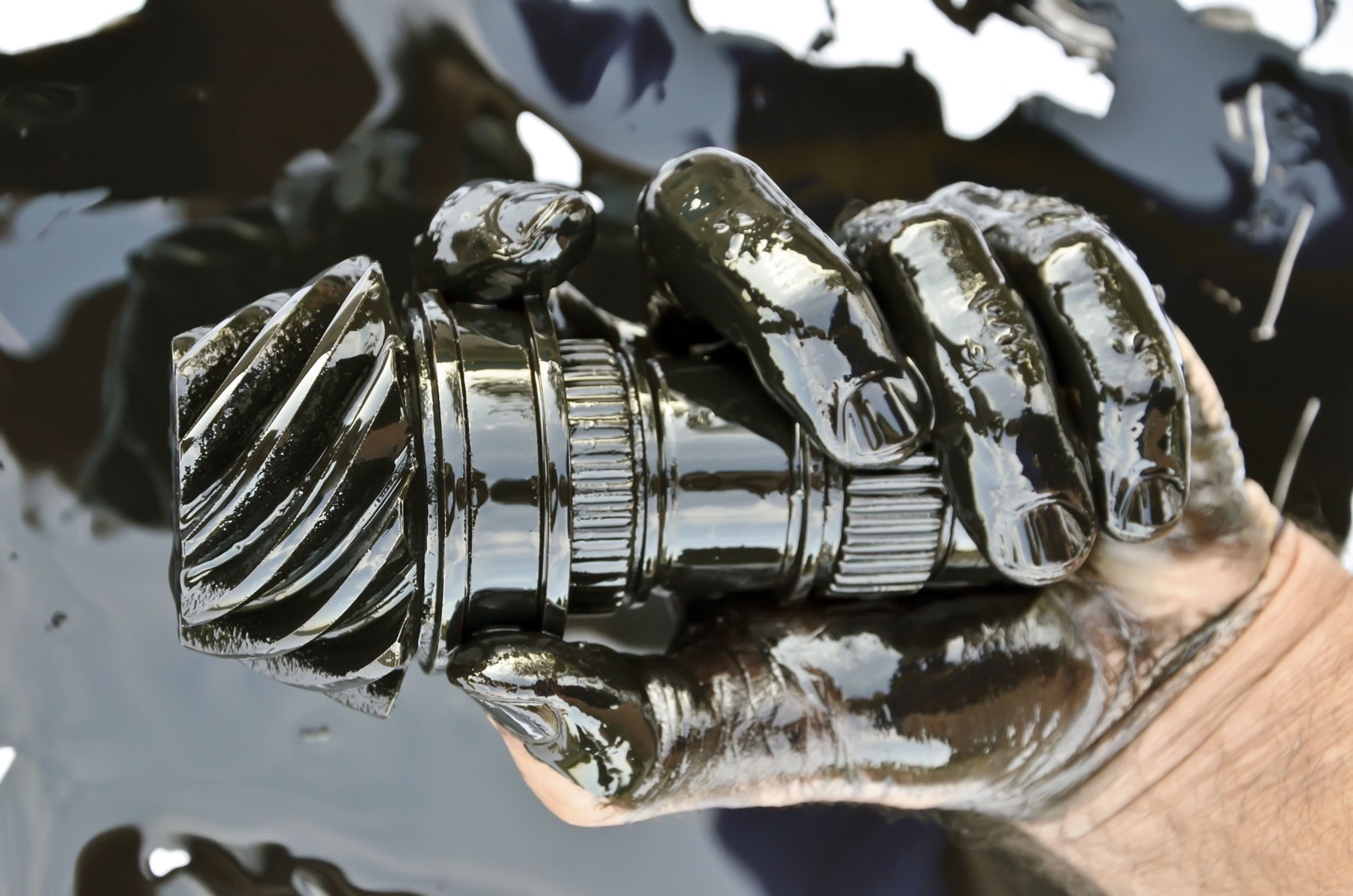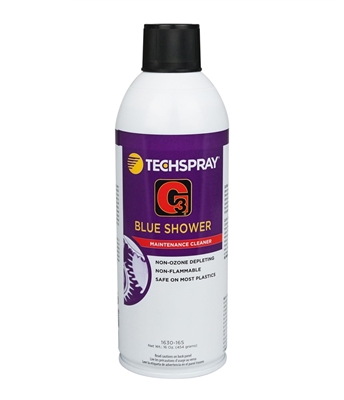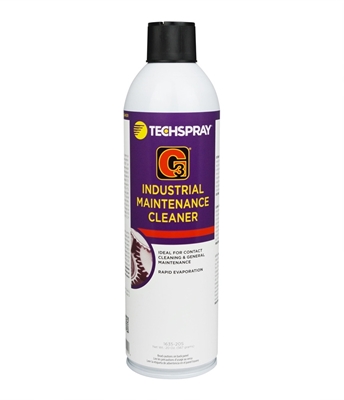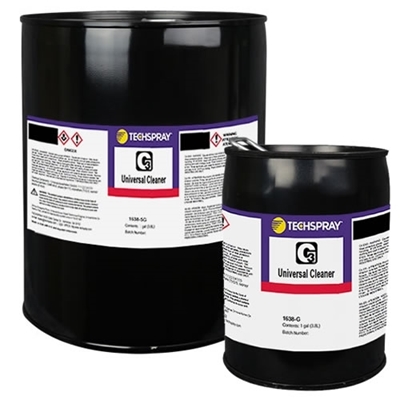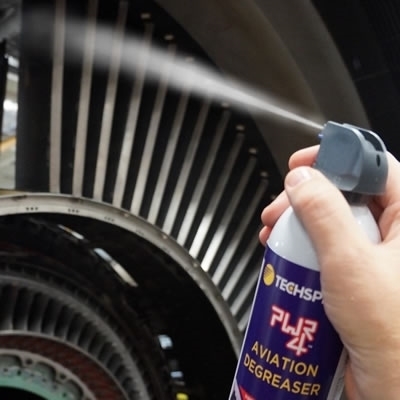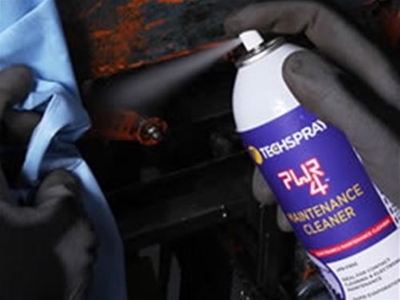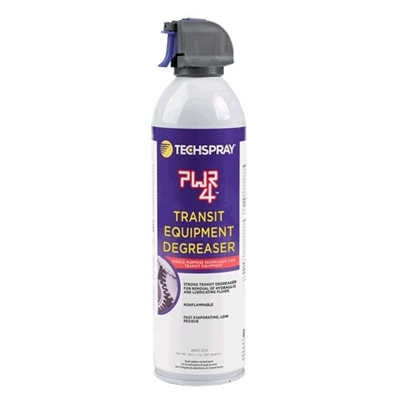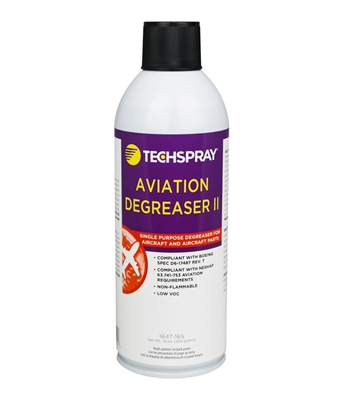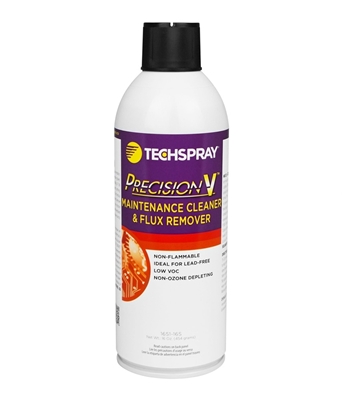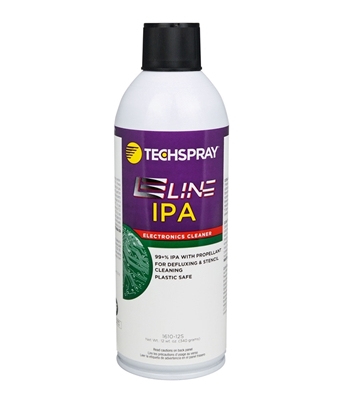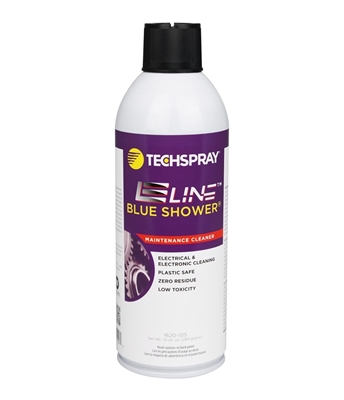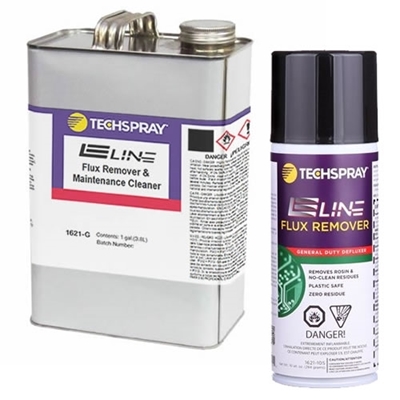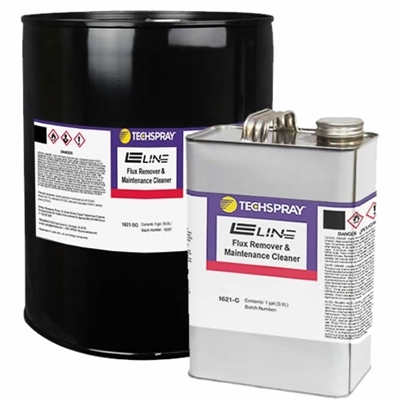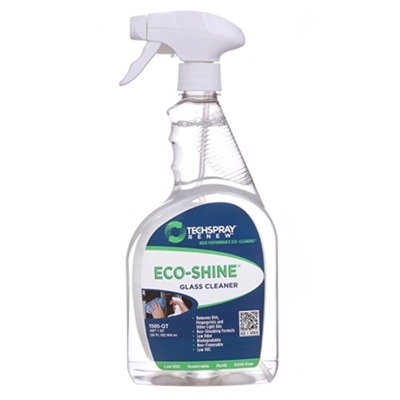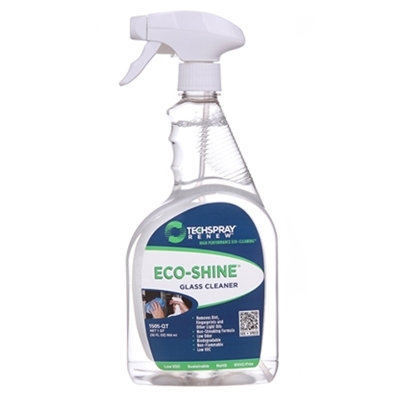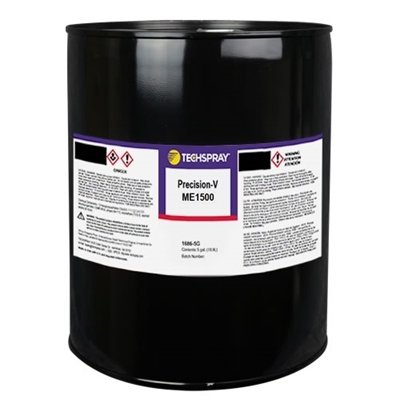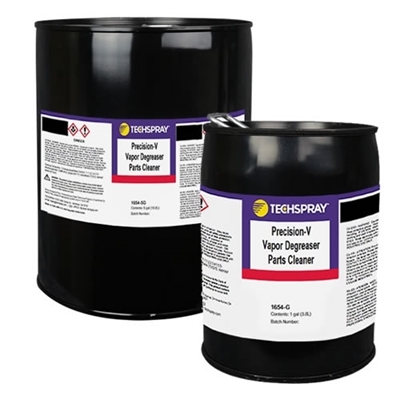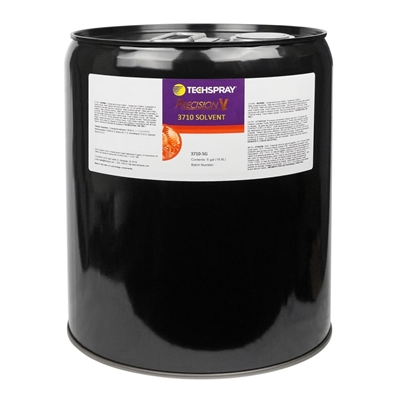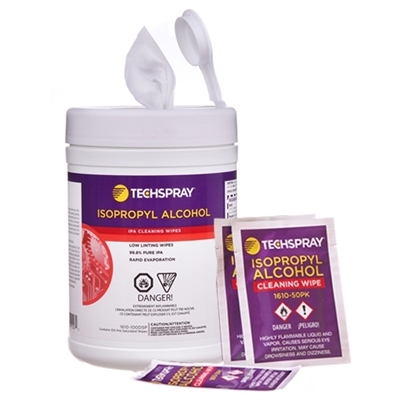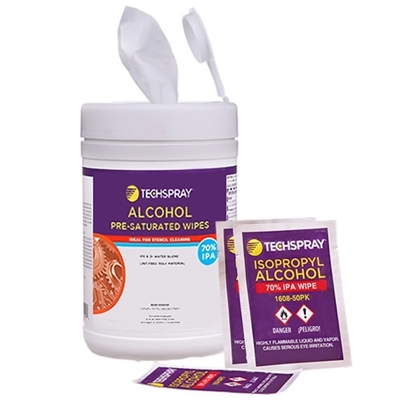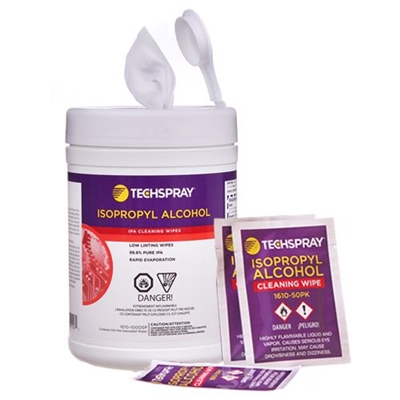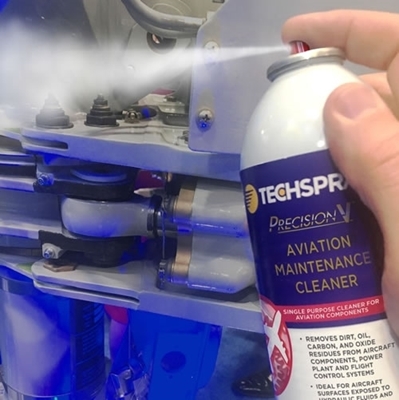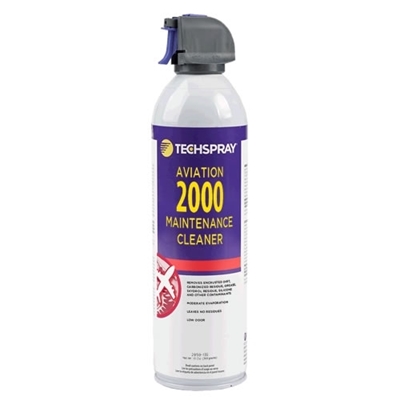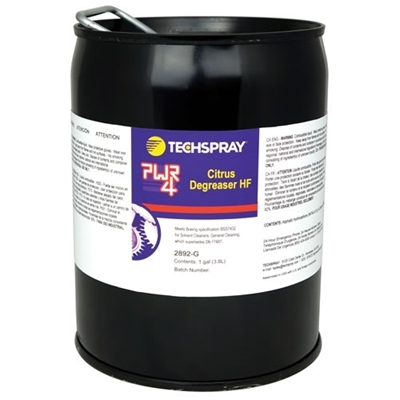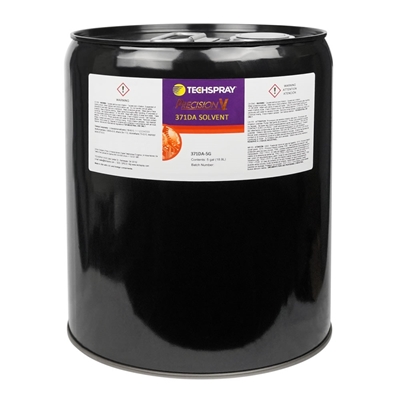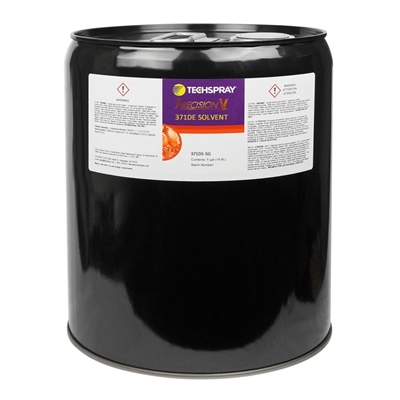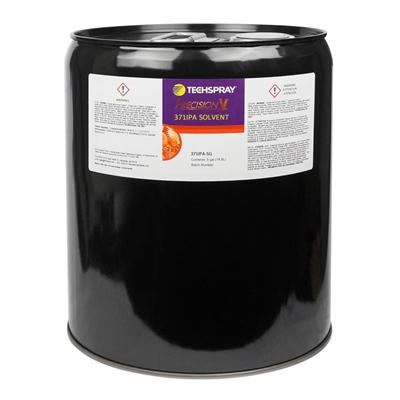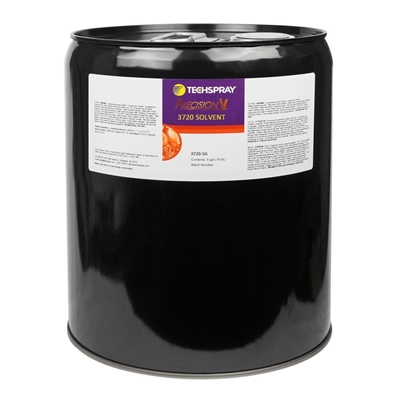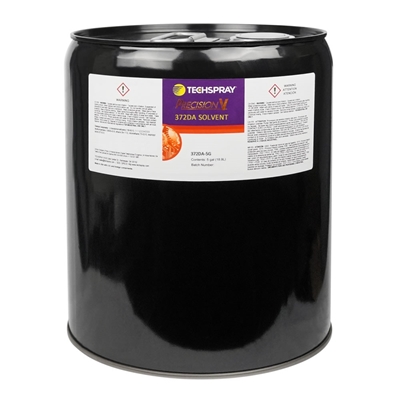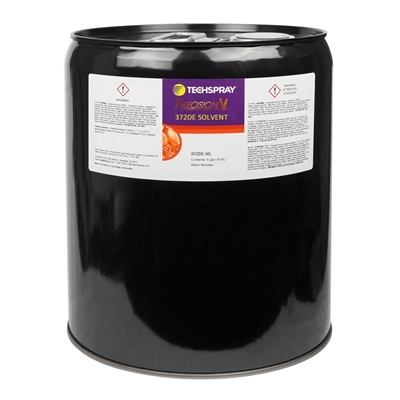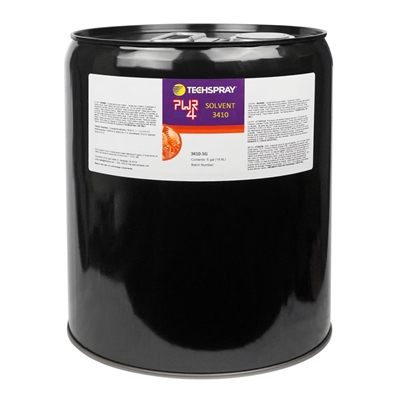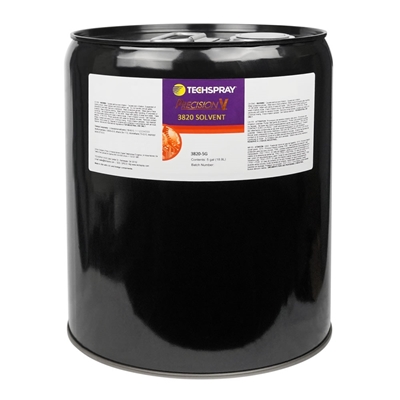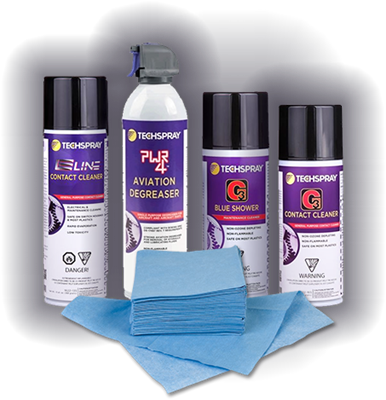What is a degreaser?
A degreaser is a cleaner designed to remove grease, oils, cutting fluids, corrosion inhibitors, handling soils, fingerprints, and other contamination common in assembly, stamping and other metal fabrication in refineries, motor repair shops, airplane hangars, and factories, etc.. Degreasers go by a number of different names including precision cleaner, maintenance cleaner, as well as several specific for automotive repair such as carb cleaner or brake cleaner.
The objective for a degreaser is to remove the offending soil quickly, avoiding as much wiping and scrubbing as possible. Degreasing solvents are commonly packaged as an aerosol for convenience. Aerosols have the added advantage of providing a forceful spray that creates agitation and which penetrate small crevices.
Water-based degreasers are common in a trigger sprayer, or in gallon or drum containers for immersion or batch system cleaning.
Specialized equipment like ultrasonic or vapor degreasers are available for more automated cleaning. These processes are repeatable, so better suited for more critical cleaning applications, like aerospace or medical appliance maintenance.
Techspray offers a large selection of degreasers and maintenance cleaners under the G3®, E-LINE™, PWR-4™, and Precision-V brands, which range from economical heavy-industry cleaners to high precision solvents for sensitive components.
Why do I need a degreaser?
Dust, dirt, grease, and oxidation contamination can cause corrosion, slipping hazards, overheating, increase electrical resistance in contact areas, and many other issues. Degreasing may be required to prep for down-stream processes like painting or plating.
Cleaner Degreasers can clean oil, grease, oxides and handling contamination from equipment and assemblies that include:
- Metal and fiber optic cable splices
- Motors and transformers
- Programmable Logic Controllers (PLCs)
- Pneumatic and hydraulic assemblies
- Electronics and electrical equipment
- Meters/measurement devices
Industrial-strength degreasers are needed to remove grease, tar, asphalt, oil, and grime in these kinds of applications:
- Clutches, armatures, generators, and compressors
- Electrical motors and equipment
- Bearings, chains, cables, pulleys and gear drives
- Brakes, springs, and flywheels
What is the difference between a degreaser and a contact cleaner?
Degreasers are intended to remove oil, grease, oxides and handling contamination from equipment and assemblies, while a contact cleaner does the same thing specifically for electrical contacts.
A contact cleaner (also called electrical cleaner, switch cleaner, electrical contact cleaner, and (specific for automotive repair) battery terminal cleaner removes contamination from electrical contacts, the conductive surfaces of connectors, switches and other electrical and electronic components with moving surface contacts.
What do I look for when selecting a degreaser?
There are several factors that can have a big impact on performance and safety in choosing the proper degreaser for a given application in an environment:
Flammability – Degreasers often contain very flammable alcohols and hydrocarbon solvents. They can be cheap and effective, but can be dangerous without proper ventilation, or around open flames, sparks (e.g. from welding), or hot surfaces. Nonflammable degreasers avoid these safety issues but are generally more expensive. In addition, some nonflammable cleaners can be very toxic, containing hazardous solvents like Perchloroethylene, trichloroethylene or n-propyl bromide. High flashpoint (often called “high flash”) solvents have vapors that are less likely to combust in normal ambient temperatures (say below 140°F/60°C).
Dielectric strength – If you plan to work on powered equipment, or need to switch it on before the solvent has flashed off, consider a degreaser with a high dielectric strength. Make sure you know the amperage and voltage of the circuits you are trying to clean before spraying anything onto the circuits, and evaluate the suitability of any cleaner in your application. Dielectric strength is the maximum electric field that the material can withstand before its insulating properties break down. The lower the dielectric strength, the more likely it will breakdown and allow electricity to flow through and short out.
Plastic / rubber compatibility – Care needs to be taken when cleaning plastic or components, rubber gaskets and seals. If the degreaser is incompatible with the plastic, it can craze (create small cracks), embrittle, or soften the material. Rubber seals may swell, shrink, or dissolve. A new degreaser should always be tested before being used broadly.
Toxicity – N-Propyl Bromide (nPB), Trichloroethylene (TCE) and Perchloroethylene (Perc) are highly toxic chemicals commonly used in degreasers to provide cleaning performance in a nonflammable formula. There are documented court cases where workers suffered major health effects when exposed to high levels of these chemicals. Workers reported headaches, dizziness, and even loss of full body control. There are also possible links to reproductive problems and cancer. All of this has caused maintenance facilities to reconsider their solvent choices, especially with manual cleaning when exposure tends to be higher.
Environmental issues – Volatile organic compounds (VOCs), solvents that add to smog, or solvents with high global warming potential (GWP) have been a focus of regulators. Some state (e.g. CARB, the California Air Review Board), municipal, and even industry-specific regulations restrict the use of high VOC or high GWP materials.
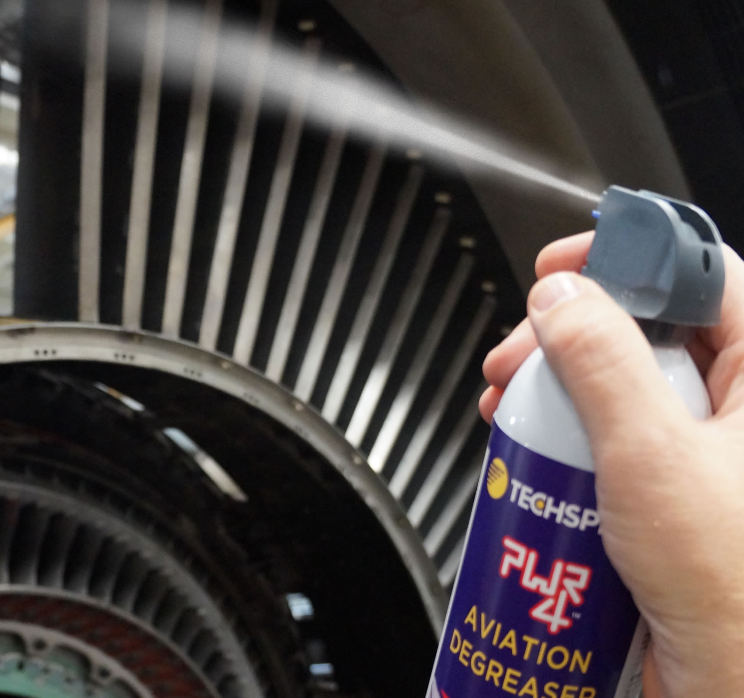
What are the cleaning processes to consider for degreasing?
Manual Degreasing Methods
It is common to clean grease and oil off of parts at a benchtop, work station, or in the field, which generally requires a manual cleaning method. Manual cleaning methods are more labor-intensive and less repeatable, so results vary from operator to operator.
- Aerosol – Aerosol packaging is a sealed system, which ensures fresh solvent. The spray pressure and application pattern add agitation, like a scrubbing action. A straw attachment is generally included to spray into tight areas or for focused application.
- Trigger spray – Spray bottles are common for water-based cleaners and isopropyl alcohol (IPA), but not for aggressive solvent cleaners.
- Liquid immersion – The part can be immersed in a tray or bucket of solvent cleaner, and then wipes, swabs and brushes scrub off tough soils. Heating the solvent can improve the cleaning performance, but for safety sake, should only be done with nonflammable degreasers.
- Presaturated wipes and swabs – For added convenience, wipes are available presaturated with a mild solvent like isopropyl alcohol.
Automated or Semi-Automated Degreasing Methods
For higher-volume manufacturing or if minimal variability is required, like in critical applications like aerospace and medical, more automated cleaning methods are available.
- Ultrasonic – Ultrasonic cleaning equipment use sound waves to break apart grease and lift it off the part. Ultrasonic equipment usually has the option of heating the cleaning material to increase cleaning performance. Cross-contamination can be a concern, so change the solvent regularly. Also consider that ultrasonic cleaning might be too rough on sensitive parts or materials.
- Vapor degreaser – Vapor degreasing is the best cleaning process for critical cleaning, like in aerospace and medical applications. Parts are submerged in a sump of boiling solvent or in a rinse sump with ultrasonics and rinsed in solvent vapors. Specialized azeotropes or near-azeotrope solvents are required to avoid problems as the solvent is boiled and reconstituted repeatedly.
- Batch washer – Parts are either stationary in a rack or run on a conveyor, and the degreasing agent (often water-based and highly caustic) is sprayed over the parts.
Does a degreaser need to be nonflammable?
Nonflammable degreasers are the safest options if they will be used near sparks, open flames, or hot surfaces. Techspray has several nonflammable degreasers available, including G3® Maintenance Cleaner, PWR-4™ Industrial Maintenance Cleaner, and Precision-V Maintenance Cleaner & Flux Remover.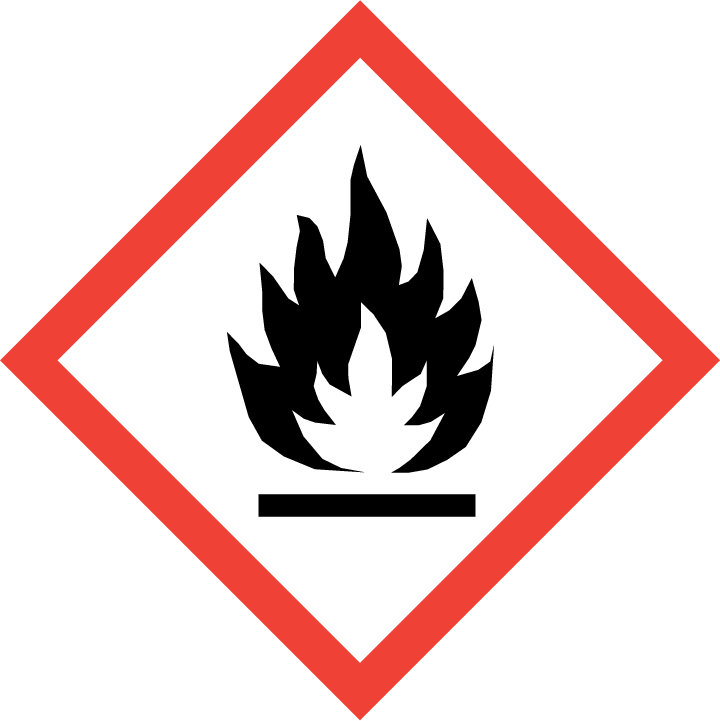
The most common method of identifying the flammability rating of a degreaser is the GHS (Global Harmonized System) flammable pictogram (see diamond symbol above). Other standards, like NFPA (National Fire Protection Association) and HMIS (Hazardous Materials Identification System), provide a rating from 0 to 4, zero being the lowest flammability rating equivalent to nonflammable.
Do I need to shut off power before cleaning electrical equipment?
Before you start spraying, shut down power to avoid the potential of sparks, electrical shorts or discharges, and other safety hazards. If disconnecting the power is not an option, look for degreasers with a dielectric strength above 30 kV (30,000 volts). Choosing a nonflammable cleaner would also add a layer of safety in case of unforeseen sparks.
Should I worry about plastic packaging and components and rubber seals when degreasing?
Rigid plastics like ABS, polycarbonate (trade name Lexan), and acrylic materials like Plexiglass can be very sensitive to harsh solvents like toluene, xylene, and acetone. Alcohol- and hydrocarbon-based solvents tend to be better choices for sensitive plastics.
Rubber, silicone or other seals or gaskets made of elastomeric (soft) materials can have a tendency to swell or shrink with exposure to harsh solvents. After the solvent flashes off, they may spring back to their original dimensions, or be permanently changed, impacting the effectiveness of the seal. Polyester- or Teflon-based gasketing materials are less prone to this type of damage from harsh solvents.
A new degreaser should always be tested before use on any questionable applications or using any live (and expensive) equipment. If you do have very sensitive materials to clean, Techspray offers E-LINE™ Maintenance Cleaner and Precision-V™ Maintenance Cleaner & Flux Remover which are compatible with broad array of sensitive materials.
Are there degreasers that are more toxic than others?
N-Propyl Bromide (nPB), Trichloroethylene (TCE) and Perchloroethylene (Perc) are highly toxic chemicals commonly used in degreasers to provide cleaning performance in a nonflammable formula. However, there are documented court cases where workers suffered major health effects when exposed to high levels of these chemicals. Workers reported headaches, dizziness, and even loss of full body control. There are also possible links to reproductive problems and cancer. Therefore, many are reconsidering their solvent choices, especially with manual cleaning when exposure tends to be higher.
While federal agencies have been slow in regulating nPB, CA OSHSB has listed it as a developmental/reproductive toxicant under Prop 65 with a PEL of 5 ppm. Pennsylvania has included it on its hazardous substance list. ACGIH has listed the TLV for nPB as 10 ppm, but there is a proposal to decrease it to 0.1 ppm. Comparable to TCE, PCE, and MeCl in toxicity, nPB has been determined by NTP as “reasonably anticipated to be a human carcinogen.” (source: NTP, “Report on Carcinogens, Thirteenth Edition: 1-Bromopropane”, http://ntp.niehs.nih.gov/ntp/roc/content/Tprofiles/bromopropane.pdf) Effective January 1, 2018, Ontario, Canada has implemented the ACGIH recommendations for nPB.
These risks have prompted employers and industry leaders to rethink their solvent choices, especially with manual cleaning when exposure tends to be higher than the more automated cleaning processes. Degreasing, by its very nature, is very hands-on so close control of chemical exposure can be very challenging. How many electricians do you see with a respirator? The best option is to avoid the most toxic solvents, even if they are legal and readily available.
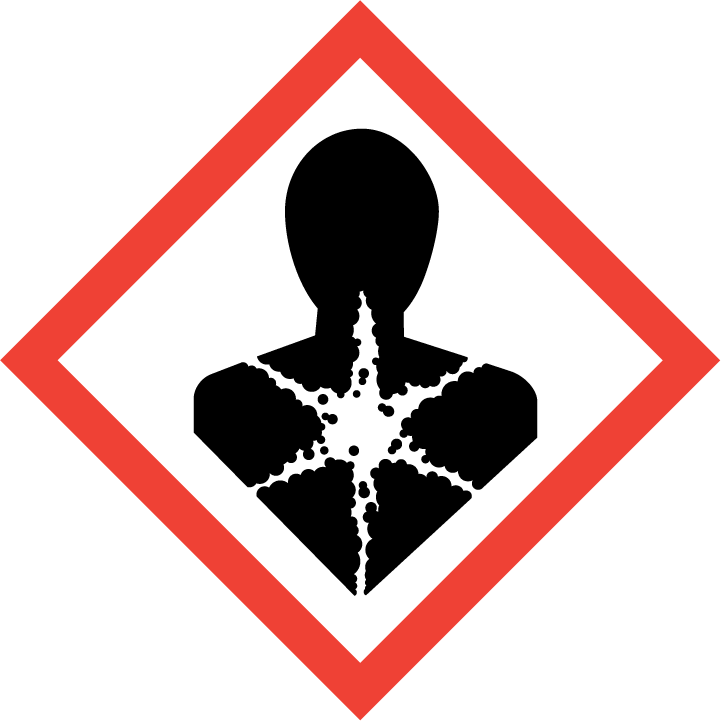
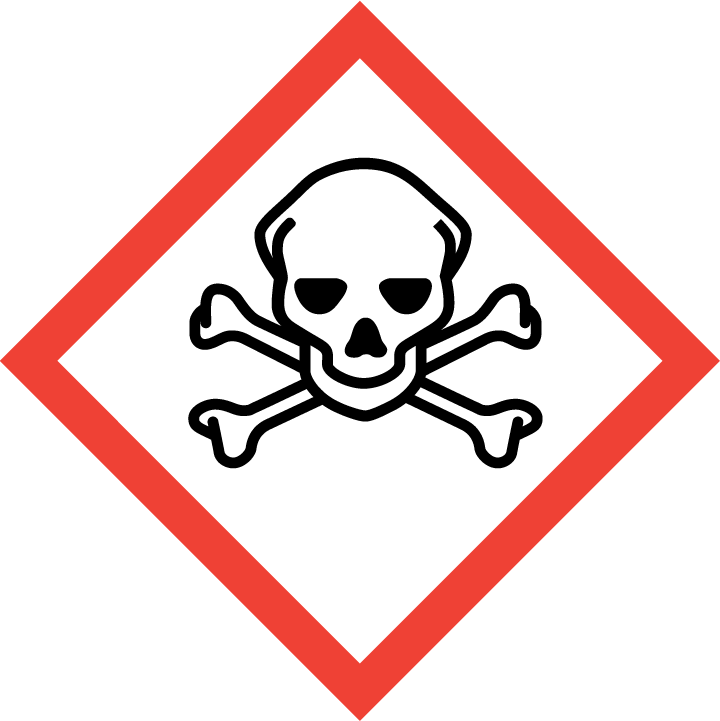
The quickest and easiest method of identifying a potential concern is the GHS (Global Harmonized System) pictograms (the diamond symbols above). The chronic toxicity pictogram (diamond containing person with exploding chest) indicates the product contains something that can cause long-term effects. That doesn’t necessarily mean a carcinogen, but it should prompt you to look closely at the Safety Data Sheet (SDS). You may need to take extraordinary measures to reduce personal exposure, or if that is unrealistic for your application then avoid the product altogether. The acute toxicity pictogram (diamond containing skull and cross-bones) means the product can have a short-term health impact. Again, check the SDS carefully if you see this symbol.
No Techspray degreaser contains toxic solvents like nPB, TCE, or Perc. While you still should pay attention to label warnings, SDS’s, and wear adequate personal protection equipment (PPE), the requirements will not be as over-the-top to stay within a safe range of exposure as with other products.
Are there environmental concerns with using degreasers?
Volatile organic compounds (VOCs), solvents that add to smog, or solvents with high global warming potential (GWP) have been a focus of a number of regulators. Some state (e.g. CARB, the California Air Review Board), municipal, and even industry-specific regulations restrict the use of high VOC or high GWP materials.
To complicate things, VOC is defined and measured differently by various agencies. A degreaser might be considered low-VOC according to the standard EPA (Environmental Protection Agency) definition but may be high according to CARB. If low-VOC is the goal, Techspray sells cleaners with minimal VOC under the Precision-V™ brand.
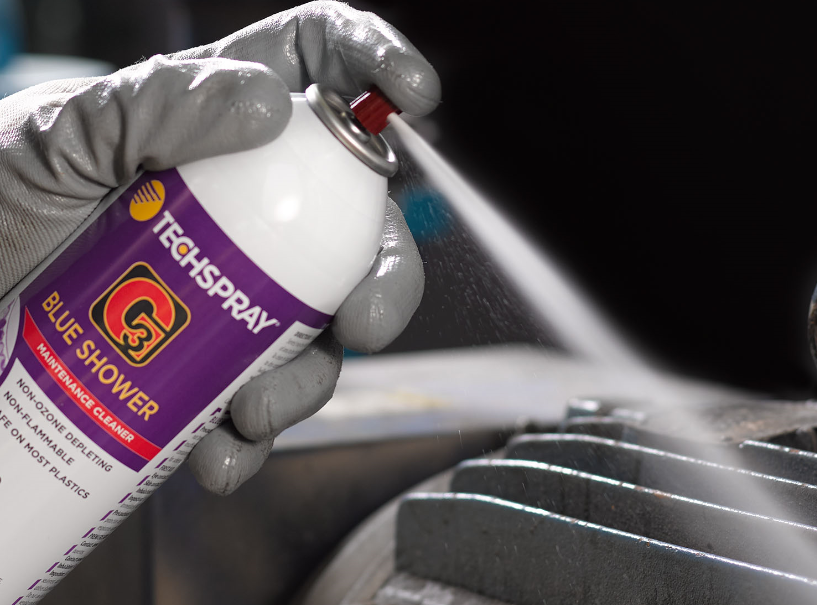
Techspray G3®, E-LINE™, PWR-4™ and Precision-V™ Degreasers and Maintenance Cleaners
Techspray offers a variety of solvents, industrial degreasers, and water-based cleaners which allows you to select the appropriate product for your cleaning needs. Maintenance cleaners clean oil and contaminants off of metal parts, printed circuit boards, barcode instruments, switch boxes, gear boxes, and engines. Techspray has produced Blue Shower maintenance cleaners for over 30 years, making Blue Shower a staple in maintenance departments all over the world!
Techspray offers a variety of solvents and water-based cleaners and industrial degreasers for the diverse and broad demands our customers encounter. Choosing a strong, high-quality cleaner saves time and money. Grease and oil flow right off, reducing the time and materials needed to scrub off stubborn soils. Our industrial strength products are available in both spray and bulk packaging options.
Techspray has a wide variety of solvent and water-based cleaners for vapor degreasing, ultrasonic cleaning, inline & batch defluxing, and aviation and aerospace applications. For help solving cleaning issues and qualifying new products and processes, contact Techspray at info@itwcce.com or 678-819-1408.
Resources

